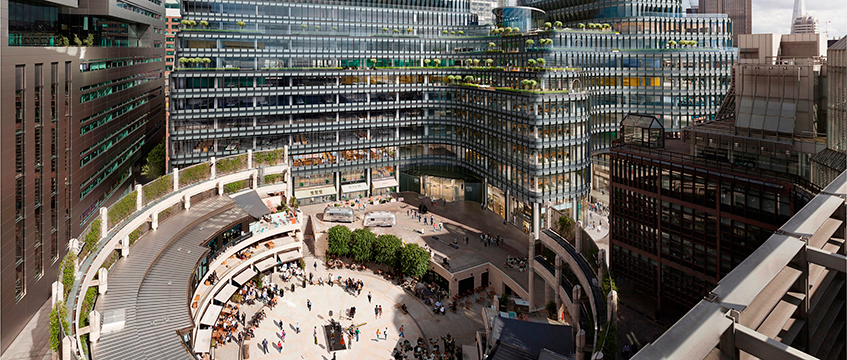EG LONDON ROUNDTABLE: Flexibility in the London office market will only grow as the increasing influence of co-working spaces forces landlords to tear up convention and meet tenants on their terms.
With London now home to as many as three times the number of co-working spaces as New York, the influence of WeWork, the Office Group and others is forcing landlords to rethink their offer – from lease lengths to design.
And while co-working spaces may only account for a small slice of the capital’s overall office market, landlords that fail to offer flexibility risk being left behind.
Listen to the podcast from the event below:
Speaking at the EG London roundtable last week, Lendlease head of offices Sherin Aminossehe said her business was changing its approach.

“Co-working as a total proportion of the amount of space available globally is still relatively small,” she said. “But for what is actually relatively small the impact that it has had on people’s thinking, it’s made some people nervous.
“What’s important for us now is to actually be a lot more nimble and flexible and think about what our occupiers may want but without putting on the same product time and time again.
“There is something to be said about more choice but real choice rather than perceived choice.
“Property isn’t always a fast business. We need to think more about who we want our future occupiers to be and actually prepare them.
“We need to have more incubators as part of our space, to be able to say that not only are we supporting the next wave of businesses, but also that we’re actually growing the pipeline of those who may want to be our customers and tenants in the future.”
Customer experience
Taylor Wescoatt, director of Concrete, the proptech venture capital business, said owners were now having to think “regularly and often” about how their customers were experiencing the spaces they offer.

“Owners are becoming increasingly asked to think as operators which is an uncomfortable position for a large property owner,” he said.
“When we think about larger businesses, we’re starting to see a trend there where, for example, WeWork is becoming the outsourced office provider for very large organisations.
“That’s driving a higher velocity to every aspect of the market.
“In London for example I think there are probably 1,200 co-working spaces. There are about 400 in New York. It’s a real change which I’m happy to say is being led by London.
“Is it just flexibility? Is it perhaps a higher quality of service? Is it an increasing focus on the experience of the new demographic of workforce?
“Everyone is wrestling with their own solution. We are at the beginning of a long climb towards what I think is probably a larger percentage of flexible office space than anyone thinks.”
WeWork joins forces on Devonshire Square deal
Carving an identity
Ben Gillam, founder & CEO of The ThirdWay Group, said landlords were already responding to the new dynamic. Eighteen months ago traditional landlords were asking his design business to help make their space look more like WeWork. That has reversed.
“Now we get, ‘please make us look nothing like WeWork’,” he said. “I spend a lot of my time in co-working spaces meeting companies who are actually quite desperate to get out and get their own identity.
“Co-working creates some really, really inspirational spaces but they’re not aspirational and most businesses in there are start-ups, they’re growing, they’re run by entrepreneurs. Entrepreneurs want their own front door.
“I think what we’re going to see now is the fight back from the real estate market.”
Read more about Lendlease’s regeneration of Euston here
That’s the direction in which Aminossehe expects Lendlease to head.
“It’s something that we’re taking quite seriously especially since our pipeline of projects is very much growing,” she said. “So hopefully soon we’ll be in a position where we have a larger portfolio of buildings that we can offer to our tenants and we can start thinking like an operator.

“So, what are the services that we’re going to be giving to our customers to make their work place somewhere where they spend a lot of time during the day, but they actually want to be and they actually want to stay with Lendlease rather than going somewhere else?”
With tenants large and small asking for overflow space for expansion – or space from where employees can work flexibly in other parts of the capital – landlords are having to incorporate more flexibility into their offer than ever.
“There are blurred lines,” said Dan Bayley, head of City agency, London, BNP Paribas Real Estate.
“There’s everything from taking space in a co-worker or having your own space in in a serviced office, taking a managed deal with maybe a two-year sublease or fag-end lease from a building owner up to going into a more mature building and taking a longer lease.
“A lot more of the bigger deals in the UK are seeing would be more commonplace in the US where you take 150,000 sq ft and you get an option to take another 20 or 50,000 in a few years’ time. That was always no-no in the UK market. That’s definitely started to become more commonplace.”
LendLease’s plans for Euston begin to take shape

“I think there is such an enormous opportunity there and obviously we are very, very excited to be part of the retelling of that story for that part of London,” said Aminossehe.
“I think a cluster is one of the things that we be looking at but obviously it’s quite early days to go into extreme amount of detail.
“You see what’s happened in Kings Cross and this is very much the natural next stop. You look at the Euston Road, you look at the institutions around there and it’s the knowledge economy – UCL, Wellcome Institute, the Crick, the British library. It has actually quite a strong residential focus to it as well.
“But the problem is the Euston Road has made sure that that’s never really been a place, even though it’s probably one of the best connected roads in the whole of London.
“So the challenge for us is to bring that into a place to make that into a location in its own right – that’s not the same as Kings Cross or not the same as somewhere else but has its own DNA. And I think that will be a really exciting new chapter in terms of central London, a new location, and a new workplace as well – especially with the links actually to the rest of the country with HS2.”
Q1 take-up highlights diversity of demand

“Quarter one’s take up in central London for major occupiers was a microcosm of the choice that occupiers now have,” says Dan Bayley, head of City agency, London, BNP Paribas Real Estate.
“There were strong take up from the likes of Sumitomo Mitsui Banking Corporation in traditional City buildings and locations like 100 Liverpool Street.
“You have towers, with Sidley Austin going to 70 St Mary Axe. You then have people like Monzo taking two-year leases from Bloomberg in Finsbury Square.
“But, at the same time, you’ve got insurer Charles Taylor taking a tiny bit more space but on a 20-year lease as opposed to a two-year lease. They’ve done that because they wanted a big incentive upfront to help pay for their fit out.
“What’s interesting to me compared to when I started doing this job over 20 years ago is the choice that occupiers have in terms of lease length, style of building and location.”
To send feedback, e-mail damian.wild@egi.co.uk or tweet @DamianWild or @estatesgazette












